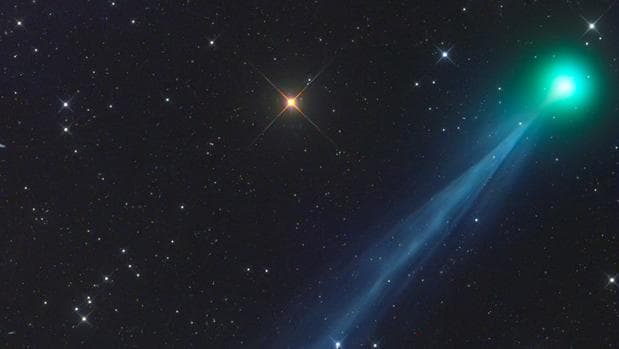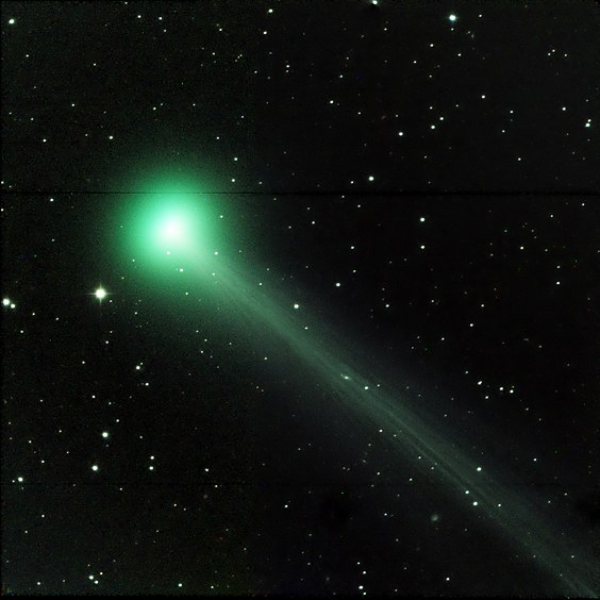
"This comet promises to be visible to the naked eye, as long as conditions allow"
By: Marcos Tulio Hostos
Comet Swan is a celestial body
that researchers say possibly originated from another star system and for
reasons unknown until now, has come to our solar system after a long journey
through interstellar space. This comet has an orbit with a high eccentricity
and therefore its return to our solar system could take place in thousands or
perhaps millions of years in the future.
Its discovery on March 25, 2020,
is part of an ingenious kite detection technique. Between the SOHO solar
observatory and a diligent amateur astronomer whose name is Michael Mattiazzo
of Australian origin; who has a unique method of detecting comets (he has
already discovered 8 comets with this method).
Michael Mattiazzo reviews images
published online daily by ESA's SOHO solar observatory and NASA. SOHO is a
solar observatory launched into space in 1995, which monitors our Sun star
permanently; SOHO records solar activity at different wavelengths of the
spectrum. The Australian astronomer specifically studies those produced by the
instrument called SWAN (hence the name of the comet) dedicated to ESA's Solar
Wind Anisotropies aboard the SOHO observatory in cooperation with NASA.
This instrument is dedicated to
capturing images in ultraviolet light of the changes of the solar wind with its
variable flow of charged particles that expels the Sun into space. This
instrument has proven to be very effective in detecting comets due to its
ability to capture the hydrogen and oxygen that are common elements in comets.
The nuclei of comets have large
amounts of hydrogen in frozen form, which are released as water vapor when
exposed to the action of solar wind particles. This is what allows the
formation of a coma and usually the long tails of comets made up of ionized
gases like dust particles.
 In general, the cometary nuclei
in our solar system come from two regions, the Oort cloud at a distance between
50,000 and 100,000 AU (Astronomical Units) from the Sun and the Kuiper belt
located beyond the orbit of Neptune, a place where long-period comets originate
but we also occasionally get visited by cometary bodies formed in other distant
star systems.
In general, the cometary nuclei
in our solar system come from two regions, the Oort cloud at a distance between
50,000 and 100,000 AU (Astronomical Units) from the Sun and the Kuiper belt
located beyond the orbit of Neptune, a place where long-period comets originate
but we also occasionally get visited by cometary bodies formed in other distant
star systems.
The SOHO solar observatory has an
impressive record of detection of comets, Comet Swan is number 3932 discovered
by this probe, SOHO has normally discovered comets with its coronagraph which
is an instrument to observe the solar corona using a metal disk that cover the
bright part of the Sun; This allows us to see that area as hot as the solar
corona is; it is among the crown that the presence of comets has been captured
..
The Swan Comet promises to be a
very visually attractive comet for the inhabitants of our planet; This comet,
possibly, if the calculations are fulfilled, has a large amount of matter that
constitutes its nucleus, as the calculations so far demonstrate. It will be so
bright that it will possibly be possible to observe it in the northern
hemisphere with the naked eye by the end of May when its brightness is expected
to increase.
All comets that visit us run the
risk of disintegrating and disappearing or simply diminishing their nucleus.
The action of the Sun's gravitational field on a cometary nucleus is an
excessive test of wear due to the fragile material of its composition. On May
27 it will be the acid test of Comet Swan, since it will have its closest
approach to the Sun (Perihelion 0.43 AU) receiving all its caloric power and
gravitational disturbance.
If Comet Swan manages to survive
this odyssey, lovers of celestial objects will be able to locate the comet in
the vicinity of the star Capella of the constellation Auriga (El Cochero) in
late May, this being the only opportunity to see this body. celestial before it
is lost for thousands of years or perhaps much longer; its orbital parameters
predict (they are not yet definitive) that its orbital eccentricity is
hyperbolic.
 Comets or cometary nuclei more
appropriately; they have their origins in the formation of star systems. When a
protostar forms in the Universe, a disk of matter made up of gases and solid
material forms around the star. By accretion, bodies are formed that in the
future will be both gaseous, telluric and rocky planets. When this formation is
consolidated, the edge of the disk is fragmented into objects that contain the
primordial matter of the formation of a stellar system, thus constituting the
cometary nuclei; true capsules in time with valuable information on the
composition of the original matter of our Solar System. The study of the
material that makes comets are rich in information about the origin of the
formation of our Solar System since its composition has remained intact for
millions of years.
Comets or cometary nuclei more
appropriately; they have their origins in the formation of star systems. When a
protostar forms in the Universe, a disk of matter made up of gases and solid
material forms around the star. By accretion, bodies are formed that in the
future will be both gaseous, telluric and rocky planets. When this formation is
consolidated, the edge of the disk is fragmented into objects that contain the
primordial matter of the formation of a stellar system, thus constituting the
cometary nuclei; true capsules in time with valuable information on the
composition of the original matter of our Solar System. The study of the
material that makes comets are rich in information about the origin of the
formation of our Solar System since its composition has remained intact for
millions of years.
The opportunity to observe a
comet during a person's life can be an extremely rare event for many human
beings during the history of Humanity. There are people who have died of
advanced age and unfortunately lived in periods when the arrival of comets in
the vicinity of our Sun was very little or completely null. Observing those
bright celestial bodies with a long tail that at different periods of human
history appeared unexpectedly in the night skies, frightened many, I think
confusion and stoked the trickery or possibly secured in power some ruler who
knew how to take advantage of the effect of the vision of the comet in most of
the community.
Today we must feel privileged to
live in a period of time where in a relatively short time we have been able to
enjoy several comets with their frozen bodies from distant interstellar regions
and those that revolve around our Solar System. I hope we enjoy the short visit
from Comet Swan, the lonely frozen traveler.
Credits
Royal Observatory
United space in Europe
Cienciaplus
Wikipedia
No hay comentarios:
Publicar un comentario